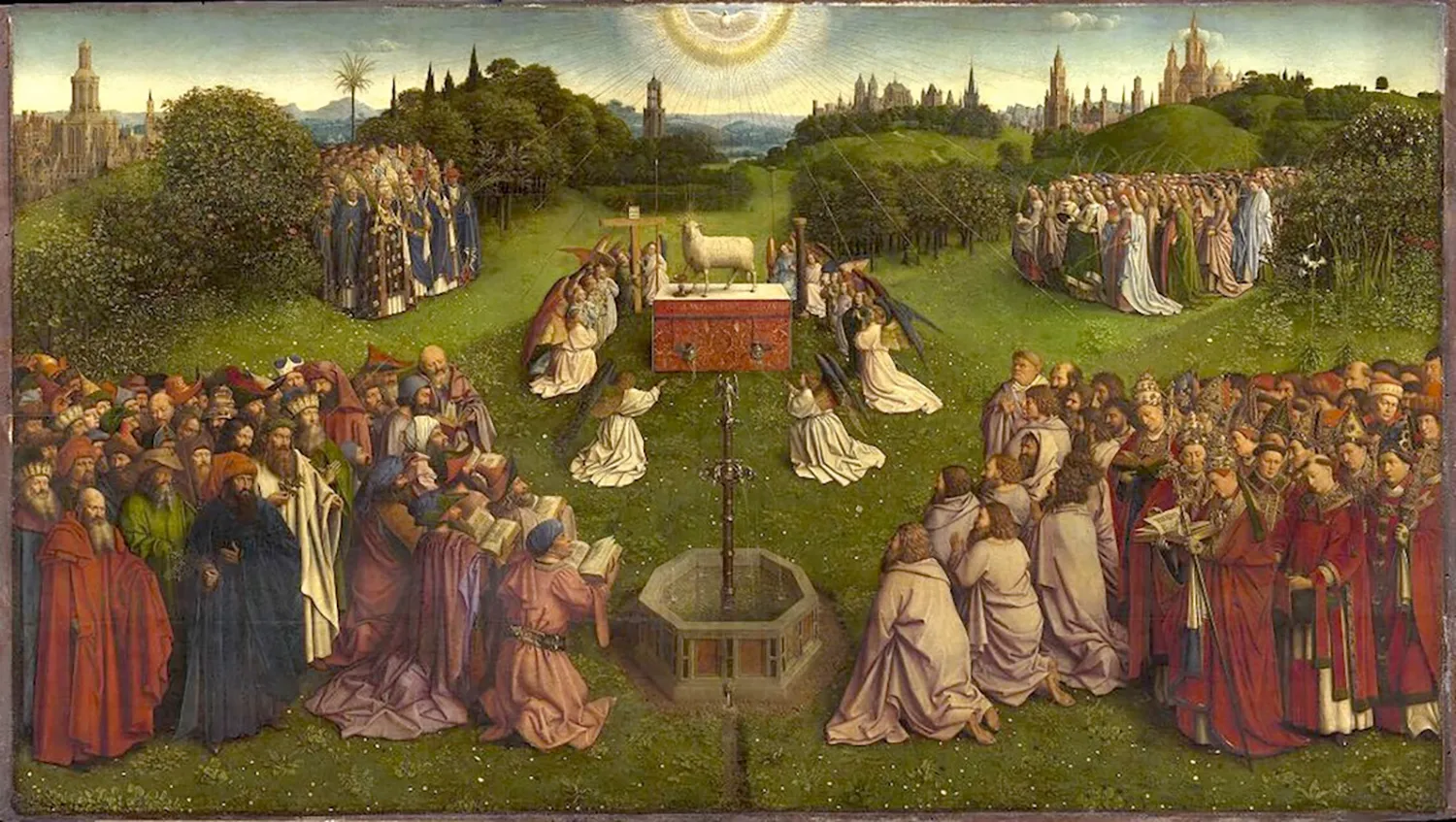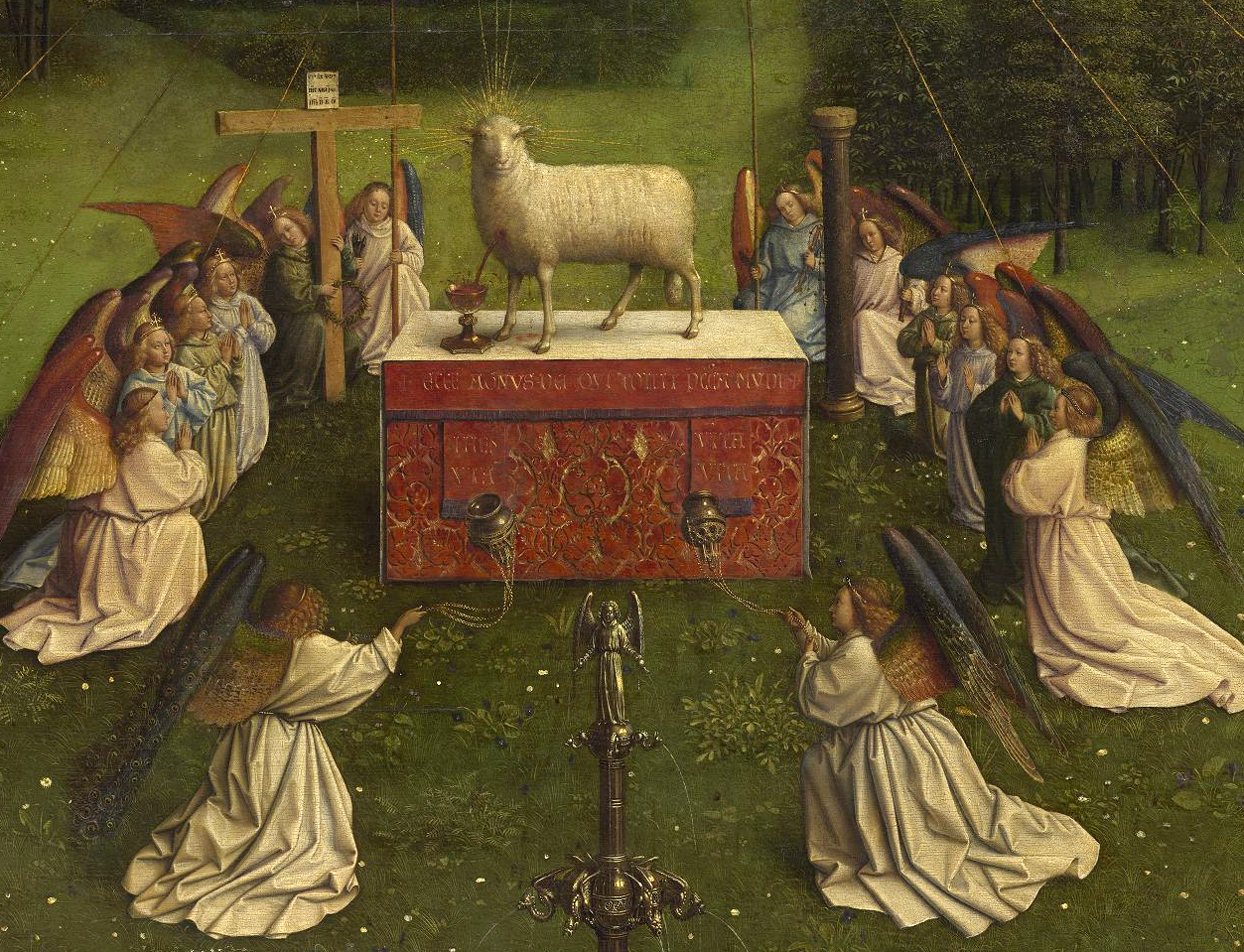The Ghent Altarpiece: Meaning, Mystery, and Mastery
Introduction: Why the Ghent Altarpiece Still Captivates
It’s been stolen more than once. Nearly destroyed in war. Dissected by scholars. Adored by artists. The Ghent Altarpiece, also called The Adoration of the Mystic Lamb, is one of the most significant—and complex—works of Christian art in the Western world.
Created in 1432 by Jan van Eyck (and possibly his brother Hubert), this massive polyptych resides in St. Bavo’s Cathedral in Ghent, Belgium. It tells the sweeping story of salvation—visually stunning, theologically dense, and full of hidden surprises.
Before we dive into each panel, let’s begin with some of the most remarkable things you might not know about this legendary work of sacred art.
The Ghent Altarpiece, painted by Jan van Eyck, is a monumental 15th-century polyptych overflowing with symbolism, detail, and theological depth. Its panels depict scenes from heaven and earth—most famously, the central image of the Adoration of the Mystic Lamb. This masterpiece captures the fullness of God’s redemptive plan with breathtaking precision.
1. The Missing Panel: What Happened to “The Just Judges”?
Of the altarpiece’s original 12 panels, one remains missing: The Just Judges. In 1934, it was stolen from the cathedral, and to this day, it has never been recovered. Some believe it was hidden in a crypt. Others suggest it was destroyed. In its place, a faithful replica now fills the gap.
Learn more via The Times
Background from Wikipedia
The mystery adds to the painting’s intrigue—and theological richness. A justice forever longed for but not yet seen?Theologically, that’s profound.
2. A Work of Radical Detail and Spiritual Imagination
Van Eyck’s mastery of oil paint allowed for realism far beyond his time. Look closely:
Light reflects in angel brooches.
Dew sparkles on blades of grass.
Tiles bear inscriptions that reference Christ and Mary.
This level of detail invites contemplative viewing—what monks would call lectio divina with the eyes.
Explore high-resolution panels at Closer to Van Eyck
3. Panel by Panel: A Journey Through Salvation
When closed, the Ghent Altarpiece presents a somber, grayscale vision of the Annunciation across its panels. At nearly 12 feet high and 15 feet wide (11’6” × 15’1”), this massive polyptych was completed in 1432 by Jan van Eyck, building on work begun by his brother Hubert. The exterior panels depict prophets, sibyls, and donors in quiet reverence, hinting at the glory revealed when the altar is opened. Source
Closed State (Exterior Panels)
When the altarpiece is closed, viewers see an annunciation scene flanked by Old Testament prophets and Sibyls—those believed to have foretold the Messiah. Below, portraits of the donors (Jodocus Vijd and Lysbette Borluut) are shown alongside St. John the Baptist and St. John the Evangelist.
Symbolism: The monochrome statuesque Johns represent timeless truth. The prophets hold scrolls—links between old covenants and new hope.
Open State (Interior Panels)
When fully opened, the Ghent Altarpiece bursts into color and theological complexity, revealing a radiant vision of salvation history. The top row consists of five vertical panels, each bearing profound symbolic meaning and intricate detail.
1. God the Father (Center Panel)
At the heart of the upper tier sits a majestic figure often identified as God the Father, though some argue it is Christ in judgment. Clothed in rich red papal robes and crowned with an elaborate tiara, He raises His right hand in blessing and rests His left on a scepter. A richly adorned book—likely the Book of Life—sits open on His lap. The golden embroidery and crystalline throne reflect divine majesty and authority. This central panel anchors the visual theology of the entire altarpiece: God reigns, and His glory invites worship.
2. Mary, Queen of Heaven (Viewer’s Left)
To the left of the central figure is the Virgin Mary, enthroned and reading quietly. Her blue robe is heavily embroidered with gold, and she wears a crown of roses and lilies. Mary’s posture and expression suggest calm devotion; she is the Sedes Sapientiae—the Seat of Wisdom—and a symbol of contemplative grace. This panel evokes her intercessory role and her exaltation as Queen of Heaven.
3. John the Baptist (Viewer’s Right)
To the right of God the Father is John the Baptist, wearing his traditional camel hair garment. He gestures with his hand, as if proclaiming the arrival of the Lamb of God. With tousled hair and a solemn gaze, John bridges the Old and New Testaments, serving as the prophet who prepares the way for Christ.
4 & 5. Angelic Musicians (Far Left and Far Right)
Flanking the central trio are two panels of angelic musicians, dressed in white liturgical garments. On the viewer’s far left, angels sing in polyphonic harmony from choir books; on the far right, others play intricate medieval instruments, including a harp and a portative organ. Their rapt expressions and detailed garments elevate the entire composition into a heavenly liturgy. These panels reflect the worship of heaven, visually connecting the celestial and terrestrial realms.
Lower Register (Interior Panels)
The lower register of the Ghent Altarpiece features the Adoration of the Mystic Lamb, surrounded by saints, judges, martyrs, and pilgrims in a lush, symbolic vision of eternal salvation.
The bottom tier of the open altarpiece draws the viewer into a panoramic vision of salvation, centered on the Eucharistic Lamb of God and surrounded by saints, martyrs, prophets, and church leaders. Here’s how the panels break down:
1. Central Scene: The Adoration of the Mystic Lamb
Here, the Lamb of God is worshipped. Notice the lamb’s blood fills a chalice on the altar, and, functioning as a throne, provides life-giving water from the fount.
In the middle, a lamb stands upon an altar, bleeding into a chalice—a striking symbol of Christ’s sacrificial death and ongoing presence in the Eucharist. The Lamb is surrounded by angels in adoration. Overhead, a dove representing the Holy Spirit radiates golden beams. Groups of pilgrims and saints approach from all sides: apostles, prophets, martyrs, and righteous judges. The lush garden is filled with symbolic flora—every detail contributing to the visual theology of redemption.
Key theological motifs:
The Lamb (John 1:29) is alive yet bleeding, representing the risen Christ whose sacrifice is eternally effective.
The four fountains at the base likely represent the four Gospels or rivers of paradise (Genesis 2:10).
The assembly includes figures from across time, echoing Revelation’s vision of a great multitude worshiping the Lamb.
This section of the Ghent Altarpiece is part of the Adoration of the Mystic Lamb. The fountain has a Latin inscription from the Book of Revelation:
“Hic est fons aquae vitae procedens de sede Dei et Agni”
(“Here is the fountain of the water of life, proceeding from the throne of God and of the Lamb.”)
2 & 3. Left of Center: The Just Judges and the Knights of Christ
Just Judges: These figures represent righteous civil leaders, possibly modeled on contemporaries of Van Eyck. One mounted figure is sometimes identified as Hubert van Eyck, Jan’s brother.
Knights of Christ: These armored figures likely represent martyrs who defended the faith—saints such as St. George or St. Sebastian.
This labeling from SmartHistory is insightful and helps the viewer understand the sections and people included in the Ghent Altarpiece.
4 & 5. Right of Center: Hermits and Pilgrims
Hermits: Clad in coarse robes, these contemplatives include saints like Paul the Hermit and Anthony the Great, representing the monastic and ascetic tradition.
Pilgrims: On the far right, a diverse group of pilgrims processes forward, including St. James the Greater, easily identified by his scallop shell.
4. The Restoration That Shocked the World
Between 2012–2020, conservators embarked on a massive restoration project. What they found shocked everyone: Van Eyck’s original Lamb of God had a very human face, which had been painted over centuries ago. When the overpaint was removed, a strangely intense, forward-facing lamb was revealed.
5. Van Eyck’s Theological Worldview
The altarpiece isn’t just beautiful—it’s catechesis. Everything points to Christ. From the central Lamb to the prophets and angels, from creation to resurrection, Van Eyck shows a world ordered by the Gospel.
And yet, the Ghent Altarpiece is not didactic or rigid. It’s mystical. Poetic. Worshipful.
Christ is crowned but serene.
The Lamb is wounded but triumphant.
Angels rejoice while saints approach.
In many ways, this painting is a visual homily—a sermon told through pigment and light.
FAQ
Q: Where is the Ghent Altarpiece today?
A: It’s in St. Bavo’s Cathedral in Ghent, Belgium. Parts have been moved to a climate-controlled chapel nearby.
Q: Who painted it?
A: Jan van Eyck is credited with completion, but inscriptions suggest his brother Hubert began it.
Q: Why is one panel missing?
A: The Just Judges panel was stolen in 1934 and never recovered.
Q: What is the Lamb of God?
A: It symbolizes Jesus Christ as the sacrificial Lamb (see John 1:29, Revelation 5).
Enjoy More Faith in Art
👁️🗨️ View all reflections in the Faith in Art series »






